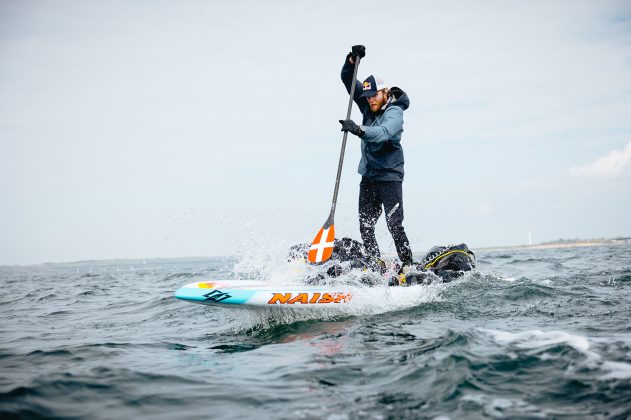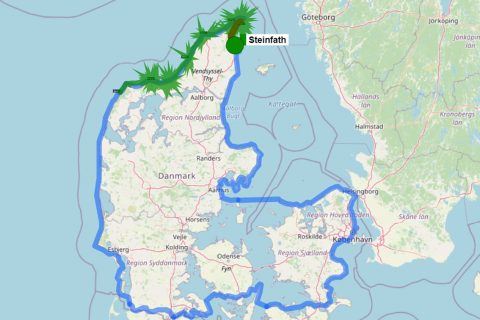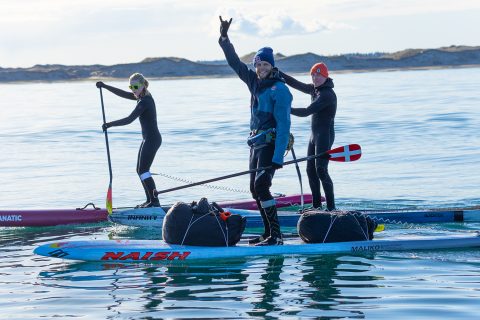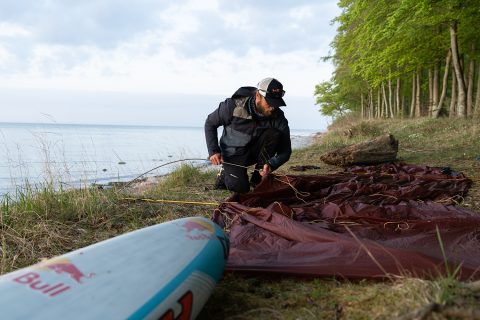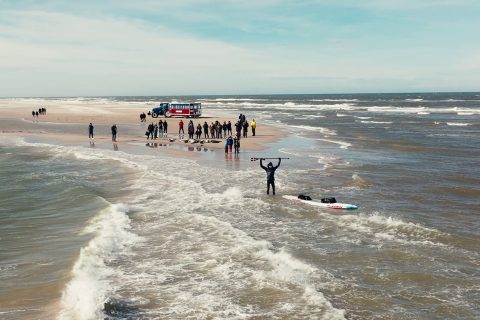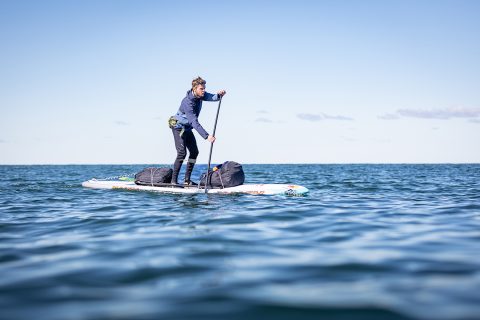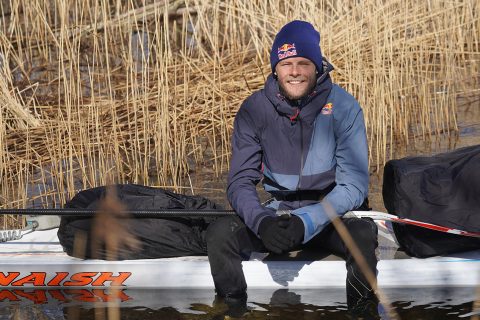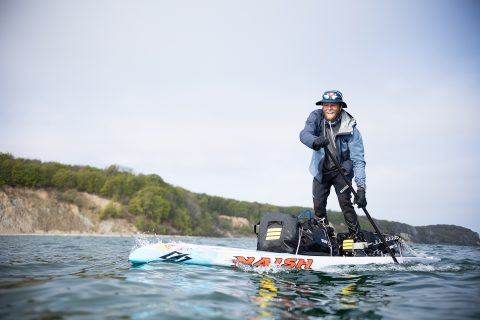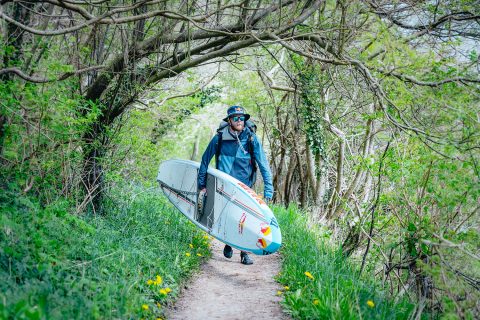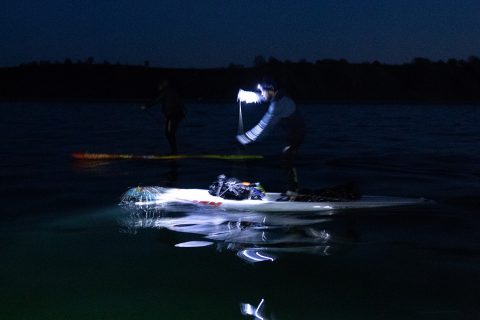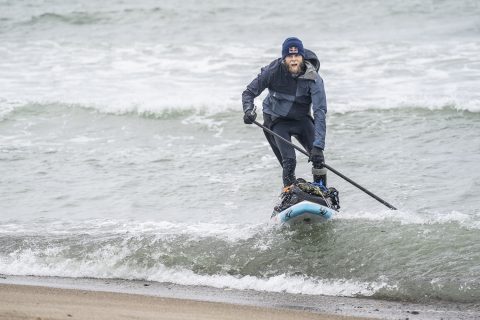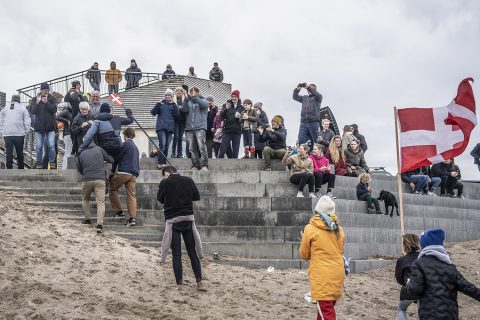THE GREAT DANISH PADDLE: CASPER STEINFATH
Known for his lust for adventure, and taking on major SUP endurance missions, Casper Steinfath recently undertook his biggest undertaking to date by paddling the whole way around Denmark, a distance of over 1450km in a mere 54 days! We caught up with Casper to find out all the details on how he managed to accomplish this crazy challenge!
Words: Casper Steinfath // Photos: Kasper Bottern (Red Bull Media House) and Emma Sondergaard.
THE IDEA
The idea came spontaneously one night when I was looking at a map back in October last year. I was inspired by all kinds of people in the SUP world that have done this type of expedition. Guys like Bart de Zwart, Chris Betish, Brendon in the UK, all inspired me. So, I just looked at a map one day and the thought just popped into my head. Nobody had done this before, so I was curious to see if I could do it. Plus I was longing for an adventure. I have this lust inside me to challenge myself, so it started as a little idea on google maps and boy oh boy did it develop into something amazing.
- The route
EQUIPMENT
Because this was a massive long mission, I knew that stability and energy conservation would be more important than speed. So I used the Naish Maliko 26 inch wide by 14 feet long board. It has much more volume than I am used to, but that was also to carry all of my kit, my tent, my sleeping bag and food. I had two paddles with me, one was a Quickblade V Drive 91 square inch, cut at around 10 cm above my head. The other was just a back up paddle in case I broke something. That was the gear I believed would give me the best possible shot at making it around Denmark.
- On a mission
ONBOARD
In the true spirit of expedition I brought a tent. I had two water proof bags that were mounted on my board with a bunch or straps. In the bags I had a two man tent, which was very lightweight. I had a sleeping bag, pillow, gas stove and extra clothing. I just tried to make it as light as possible. I had a wetsuit with me and wore it on the days I expected to fall in which I did a few times. Mostly I was paddling in thermal pants and top. Kind of like ski underwear. I also wore a 1mm set of neoprene leggings and 7mm boots. The water was cold in Denmark! I also had a windbreaker, a really strong shell jacket on top, so that combined with the thermal wear all did its job. I also had breathable gloves and a hoody. That was my set up! I opted to not go for a wetsuit or drysuit most of the time. I needed to be able to adapt to changing temperatures, which is very characteristic for spring in Denmark.
RULES
The whole thing about this project was it was not about being a speed thing. Nobody had paddled around Denmark before, so it was more about the journey. It was not about setting a time or anything. I set myself a goal of paddling roughly 30-40km a day. The total distance was approximately 1400km, so I figured with a few rest days it would take 40-50 days. You never know what can happen on a trip like this. I knew the most spontaneous things can produce the most memorable moments. I gave myself time to meet people while I was paddling. I did not have a deadline because that felt artificial. The only thing I knew was that I was getting married in August, so I had to be back by then. In terms of other rules, it was not about being self sufficient. I could go for many days without resupplying, but I went into local stores around Denmark when I needed food. I had these meal packages with me where I just had to add hot water and they worked great.
- Setting up camp
HIGHS AND LOWS
The highs and lows of the paddle were very much linked together. The highlight of the Great Danish Paddle was just doing it. From it being an abstract thing on a spreadsheet and a word document, a plan, to all of a sudden actually doing it. The mission was a huge undertaking in itself. I paddled in a snowstorm. That part was so magical to experience the snow flakes falling and these beautiful winter landscapes. I was fascinated by the snow the first few minutes, but then it turned into the most unbearably frustrating thing. Everything got wet and I was cold. I could not feel my fingers. I ended up running onto the beach to seek shelter and get warm. That was probably my highlight because it was painful. Because there was pain there were also real feelings. That just made me feel so alive. It added a survival element to the mission and I loved that. On day two, I woke up in my tent, cold, tired and hungry. I had not yet settled into a rhythm. I just knew there was so far to go at that stage. The day before I had been so excited, but when the reality hit me I knew it was going to be tougher than I had imagined. I had to really dig deep mentally to get going again and believe that I could do this. I took it one stroke at a time, one hour at a time. It became one day at a time. That was my single most low point, which was really early in the adventure.
MENTAL STATE
My mind was all over the place. When I started the paddle I was idealistic. I was thinking this was going to be the best thing ever! It did take more than a day to start second guessing myself and thinking what have I gotten myself into. That thought did appear quite regularly. I went into a downward spiral during the first week, it was only into the second week that I hit this plateau where things stabilized. The only way I can describe it was after two or three weeks, I actually got comfortable being uncomfortable. That sounds weird, but all of a sudden I got used to the feeling of being out of energy. I got used to waking up in the morning knowing I had a really tough and uncomfortable day ahead. I got comfortable in these very draining and painful circumstances. From these I knew a twelve hour day was no longer quite so hard. I got more resilient. Towards the end, even though I was happy to finish, I felt like I got so comfortable sleeping in the tent and cooking on a small stove and being cold. That was a remarkably interesting endurance to go through mentally, and I think I have come through this project slightly more hardened. But I really like my bed at home now! Food at home has never tasted as good and my bed has never felt so good to sleep in.
- Rounding the top of Denmark
MEDIA
This was a personal project for me. I wanted to challenge myself and see if I had what it took to make it around my home country on a stand up paddle board, which nobody has done before. That in a sense created a lot of interest in the Danish media. I was doing all kinds of radio interviews while paddling. I had TV stations come out in boats and follow me. I have done lots of TV and radio interviews. But also what gave the project wings was that it was it was not just my adventure. I really tried to bring people along on my journey. Both in my Captains logs and also physically on the water. I had days when there were fifty or sixty paddlers alongside me. Different clubs and groups came along. The Great Danish Paddle was received incredibly well locally in Denmark. I don’t think most people in the UK or the USA know the coastline of Denmark, but I had a feeling that a lot of people that followed this project realized that Denmark has a pretty magical coastline. It was overwhelming how much media attention I received.
THOUGHTS
Some days I had a lot of time to myself. I think the longest days were like 12-14 hours standing up paddling. I got to think about life! I was able to reflect on what I was actually doing. It was not so much why I was doing it, because I tried to stop myself second guessing myself, and thinking that it was just stupid. I got to think about what values mean to me and being away from my home, my family and my dog. I realized that my family mean the world to me. I missed them. Because I was out on the water in challenging conditions, I became very appreciative of the adventure about how tough an experience I was going through. I felt that I wish that everybody could experience this. When a rainstorm finishes and the sun pokes out, it put a smile on my face and I felt ecstatic. I felt so alive out there in the elements. I spent a lot of time thinking about how I could share this feeling. I am not sure if I could do it justice. I got to think about how I live my life, and what values and people mean a lot to me, and what it means to be human. There was some stress out there, but the stress and anxiety on the water was very immediate, it was right there in front of me. It was not like sitting at my desktop at home, worrying about paying a bill or anything like that. This was real. That is how I got to reflect on the contrast between being immersed and being out of touch. I felt so in touch with life!
- Casper enjoying one of the better weather days!
GIVING UP
I definitely felt like giving up, even by day two when I woke up in my tent, in a sleeping bag, cold, tired and hungry. All those basic needs were making me not so excited about the prospect of having to do this for a few months. I felt like giving up right there and then. There were many days when I was on the water battling tough conditions into headwinds, side winds, bumps and backwash. There were many small moments where I simply wanted to give up and just throw the towel in the ring. Somehow I just kept going. It definitely was not a dance on roses.
SKETCHY MOMENTS
There were a lot of dodgy moments. There was a snow storm on one of the first days. I was paddling through that for around seven hours. I was tired and getting really cold. I actually had a reality check and said to myself this is kind of serious. I had to be focused and stay warm. The most scary moment was when I was paddling in the Wadden Sea down in southern Denmark. I was navigating some tricky currents. All of a sudden I starred myself blind and did not pay attention to this thunder cell which was building right above me. Suddenly there was this huge boom. I had a thunder cloud above me and I had a few kilometres to paddle to reach the beach. That was scary and I had a few minutes where the hair on my neck was standing up. At the same time I felt so alive in the face of danger. I am not proud of that moment, but happy that I made it back to shore and back to shelter.
- Taking a break
MAGIC MOMENTS
It was super special paddling into some of the big cities. It was almost overwhelming. I was actually thankful to have company on the water. Being in the big cities itself was special because normally I associate going to Copenhagen with getting in a car, or train, or plane. But no, I had made it there by myself, by just paddling for a few weeks. That felt surreal. Being accompanied by 40-50 paddlers some days was incredibly special. There were a lot of questions being fired at me. I could feel everybody had questions about how I was doing it and what my strategy was. They were simple questions, but I could sense everybody had the virus of adventure. It was special to be escorted by a huge armada of paddlers on some days.
THE BODY
Some days were short, and some days were 12-14 hours on the water. I think the longest day was 16 hours of paddling. That amount of paddling was intense. The fact that it was cumulative, day in day out everyday. My body handled it ok as I was paddling at quite a slow pace, but I could start seeing muscle fatigue after a while. I lost all explosive power. I went from basically being a Formula 1 car to an old 1980’s VW diesel engine. I consider myself a fast paddler normally. I could definitely feel a degradation on my body. I was losing explosiveness, my hands were not blistering up, but they were becoming rugged. My feet got tired from standing on the board for so long some days. I made a point of sitting down while I was out there once in a while. I took breaks every forty five minutes. That was part of my strategy to let me feet and legs have a break. My body was definitely degrading. It was a steady degradation. There is no doubt I was tired, both physically and mentally.
- Casper locked and loaded
REST DAYS
I just tried to lay down as much as possible in contrast to standing up. I was on a mat in my tent. I tried to sleep as much as possible, eat as much as possible and just rest. These days to be honest were a little stressful. I also had to update my diary and upload my Captain’s logs and social media. Even though I was not paddling, I was kept busy with other parts of the project. There was a lot of forward planning to be done for my next routes and analysing weather forecasts. I looked forward to my rest days, and really enjoyed the fact that some days Mother Nature just denied me. Some days the wind was so strong that I could not go anywhere. I enjoyed just being in my tent.
TOUGHEST DAY
I think my toughest day was on one of the last days. I was battling against really wild conditions down the west coast of Denmark. There were a lot of tough days. Crossing the Kattegat Ocean with my brother was a big one. That took fifteen hours. That was a rough one. Generally the days on the west coast were long and rowdy and hard. Day 51 was very hard when I had to cross the corner of blue water and there was a lot of current, bumps and wind. The sea was pushing me around in all kinds of directions. I had to dig deep that day. The west coast really took it out of me.
- On foot!
PADDLE STROKES
My estimate for the whole mission is around 500-600 thousand strokes. I was doing a slow pace, but probably around 30-40 strokes a minute. I paddled around 277 hours in total.
FALLING IN
I did not fall in many times. My Naish Maliko was super stable most of the time even with 30 kilos of equipment. I fell in the first time when I was rounding the very tip of Denmark in Skagen – where two oceans meet. I slightly underestimated the water there, and just as I crossed the top, I was suddenly hit by a wave on my left and right at the same time. It was like a backwash. Before I knew it I was upside down underwater. Then I did not fall in again until I got to the west coast, another 1000km later. So I probably went over 1000km without falling in! When I got to the west coast in those rough conditions, we are talking about waves a few metres high, strong winds and currents, I had a fair few falls and capsizes where my board flipped over. Yep I fell in and I didn’t keep my hair dry.
SUPPORT CREW
Actually, I didn’t really have a support crew on the water. On some of the days I had a boat following me, which was more of a media boat for photos and video. I had a crew on the land, including my fiancée and my brother, who would drive along the beach, and meet up with me when I came to a harbour to say hi. I had a lot of people around me, but most of the time I was relatively close to the shore. I was 90 percent self-sufficient, but I really enjoyed seeing my family once in a while.
- Long days on the water
THE TENT
I slept in the tent around 50 percent of the time. Part of the project was about meeting the Danes! Randomly meeting people sometimes leads to generosity and people invited me in! Some nights I was sleeping in my tent and some nights I was sleeping on a mattress in a surf club, or a on a couch, and a few nights I was in a hotel that the owners gifted me. I got to sleep in a lot of unusual places. My favourite part was the tent. That became my home and my private safe space. I loved laying in the tent just listening to the wind howling outside and being swept away into my dreams.
RECOVERY
Right now, it is a week since I came ashore. I am tired, but I am also energetic in a sense that while I was paddling I could digest the mental side. Physically, I don’t expect much explosiveness from my side for a while. It will probably be a few months before I am back to 100 percent. It was more than fifty days of paddling and that leaves its mark. I feel functional right now, but I have a feeling that I might have a mental crash at some point soon. It will take a while to fully recover physically and mentally. I am not sure what it is going to feel like when I do recover, and what I will feel like doing then. I definitely will not be doing a long adventure for a while.
WHAT IS NEXT
Right now, I am just trying to be in the moment. I am enjoying laying on the couch and watching Netflix. A lot of people ask what is next. I have just paddled around a country! I kind of get frustrated at that because sometimes you just need to be in the moment. I can definitely say that this trip has only strengthened my appetite for adventure. Given the missions I have completed so far, with crossing the various Viking routes and now around Denmark, I kind of want to finish that saga. Lets throw it out there in the open. I have a dream of conquering the North Sea! Either paddling to or from Great Britain to Denmark, like the Vikings did in the old days. That is on my bucket list. That is the crossing I want to try to crack. I don’t know how I am going to do it yet. That is my guiding star, which is trying to tame the North Sea one day. That could be next year, or it could be in ten years. We will have to see. I have an appetite for adventure, and who knows, maybe even some more competition. We will have to find out once I get to recover a bit. But for now my next plan is to lay down on my couch and enjoy the moment.
- Arriving back at home
HOW DID THE EQUIPMENT HOLD UP
The board and paddle held up great. I didn’t have any significant damage on either, just wear and tear. The board was perfect for the job. It had extra volume, which was ideal to carry the 30 kilos of gear I was carrying. The board was also light enough to maintain good speed. It was a perfect set up. I probably could have used a wider board, but for me the key was stability. The board was stable enough! My paddle survived 600,000 paddle strokes! I can’t complain there! I learned a lot along the way about what equipment to use. Before this mission I was not an expert in expedition paddling, so I learned a hell of a lot along the way, what gear to bring and how to mount the gear on the board, and also what not to bring. Next time I go I will be even better prepared!
- Reception committee!
STATS
– Hours paddling: 277
– Distance: 1448km
– Strokes: approx 600,000
– Approx 5-6000 calories a day

